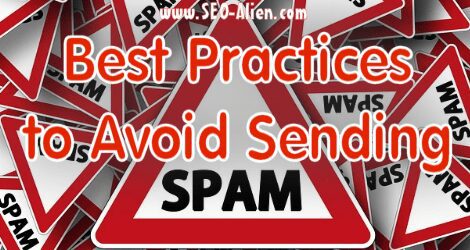Most of us take email for granted. You create the email, hit send and it goes; somewhere. Sometimes those emails go to spam. Below are 6 best practices to avoid sending spam emails.
"Anyone with an inbox knows what I'm talking about. A dozen emails to set up a meeting time. Documents attached and edited and re-edited until no one knows which version is current. Urgent messages drowning in forwards and cc's and spam." – Ryan Holmes
 When you're sending an email to somebody you hardly know, there is a chance that your email can end up in a spam folder. It is a risk every marketer should take, especially when dealing with their email subscribers and clients.
When you're sending an email to somebody you hardly know, there is a chance that your email can end up in a spam folder. It is a risk every marketer should take, especially when dealing with their email subscribers and clients.
We spend a lot of time putting these emails together. You have to come up the theme and layout and then think about creating interesting subject lines. There is a lot to do properly and lots of double checking when you send a bulk email.
But before hitting send, they should consider whether their clients or subscribers will get the opportunity to read your email. No matter how important it is, there are factors you may not even know that prevent it from sending to your client's inbox, and this can ruin a good opportunity.
Even competitive businesses such a digital marketing Philippines take their time to create their emails for their clients carefully. This is to ensure that those emails will be more likely to be on their client's inbox.
To give you a little more information on how to reduce the odds of your emails hitting the spam folder, below are 6 tips to avoid when sending emails that will help your emails avoid the spam folder.
6 Best Practices to Avoid Sending Spam Emails
- Create a Unique Subject Title
Subject titles in every email are crucial. This can be a deciding factor on whether your client would want to read it or mark your email as spam. However, creating a unique and compelling subject title is, therefore, unlikely to be in a spam folder. You can use and include your company name, the name of one of your t target's competitors, or the name of a person where your target is already familiar.
- Avoid ‘Salesy' Trigger Words
Spam filters are more likely to be triggered when they find words that contain any ‘salesy' meaning – They can be found in the subject line or in the body of your email message.
At all costs, try avoid using these type of words in your emails: Advertisements, Business, Cash, Cheap, Load, Joke, Investment, Merchant, Discount, Commodity, Congratulations, Deal, Debt, Disclaimer, Free, Offer, Obligation, Money, Refund, Rich, Spree, Spam, Save, Sales, Winner, Winning, Opportunity, Gimmick, Guarantee, Income, Profit, Price, Promotion, Shop, etc.Create a content that is professional enough for your audience to read.
You can, with practice, create content that professional for your audience to read without these spammy keywords that will most likely trigger someone's email spam filter.
- Keep The Format Simple
The moment you plan to send an email to your target client, make sure to keep it simple as possible. Avoid flowery words and get straight to the point.
Keeping it simple not just on your content, but also the design of your email. Try to avoid using colorful backgrounds, large or unusual fonts, or using a different font. That means, do not make your email look like you are promoting something. Remember, you need to avoid, ‘salesy' emails.
- Use Graphics Sparingly
If you have the need to use graphics for your content, then as much as possible, limit the number of images you use. Many spam filters assume that contents with more than one graphics are probably an adult content.
Keep in mind that (in most cases) graphics do not add much in an email. If your aim is to drive more traffic, then make it personal. It is in this way where your potential clients would be able to engage with your site.
- Limit the number of URL Links
The 5th of the best practices to avoid sending spam emails is to limit the number of URLS's (hyperlinks) in your email.
Sure, for SEO reasons, links from other sources such as emails are important. This can help drive more of your email traffic to your website. However, too many links in your content can also ruin a good email and is most likely be in a spam folder.
A good practice here is to make sure you use your links wisely. If you want to your client to click somewhere in your email, then have a single link placed prominently.
- Read and Understand the CAN – SPAM Act.
As marketers, it is important for your to know and understand what CAN – SPAM Act. Is, especially when you are into email marketing. This is to make sure that you will have an idea on what things to do and avoid to achieve a better outcome. Also, this will guide you on the penalties you would probably encounter whenever you send emails to your target clients.
These tips mentioned above are simple, yet effective enough to help your email go straight to your client's inbox. Regardless of the content, always remember to use the right approach and use these 6 best practices to avoid sending spam emails to ensure success in your business.






